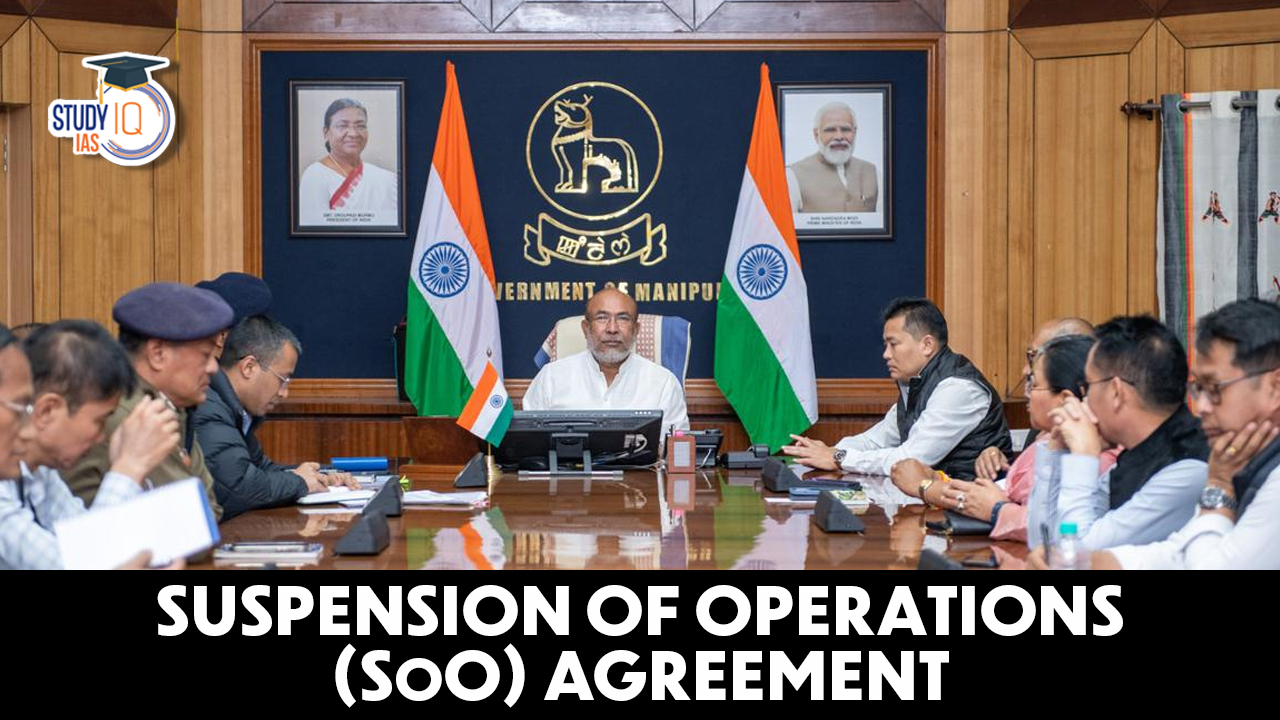Table of Contents
Context: The Chief Minister of Manipur alleged that the Kuki insurgent groups violated ground rules of the Suspension of Operations (SoO) pact and instigated violence.
What is the Suspension of Operations (SoO) Agreement?
- It was a ceasefire agreement signed in 2008, with the primary objective of initiating political dialogue with Kuki insurgent groups and meant ending violence and hostilities from all sides.
- It was signed by the Centre, the Manipur Government with two umbrella groups, the Kuki National Organisation (KNO) and the United People’s Front (UPF), comprising 25 groups – 17 under KNO and 8 under the UPF.
- There are nearly 30 Kuki insurgent groups in Manipur, of which 25 are under SoO Agreement.
- Instead of the demand for a separate state, the Kuki outfits agreed to a ‘Kukiland territorial council’, which would have financial and administrative powers independent of the Manipur Assembly.
- Terms of the SoO Agreement:
- Tenure: Period of the SoO agreement is one year; it is extendable according to the progress of its implementation.
- The SoO has been extended by the Government almost every year since 2008, with Kuki outfits threatening to breach the agreement by taking up arms again and boycotting the Government.
- Monitoring of implementation: A committee called the Joint Monitoring Group (JMG), with representatives from all the signatories, has been formed.
- No operations: Security forces, including state and central forces, are not to launch any operations, nor can the underground groups (UG).
- Designated camps: The militant cadres are to be confined in designated camps identified by the Government. Arms are deposited in a safe room under a double-locking system. The groups are given arms only to guard their camps and protect their leaders.
- Responsibilities of insurgents: The signatories of UPF and KNO shall abide by the Constitution of India, the laws of the land and the territorial integrity of Manipur. They are prohibited from committing all kinds of atrocities, extortion, among others.
- Rehabilitation package: As a rehabilitation package, the UG cadres living in the designated camps are given a monthly stipend of Rs 5000.
- Tenure: Period of the SoO agreement is one year; it is extendable according to the progress of its implementation.
- Current Stance on SoO Agreement:
- On March 10 2023, the Manipur government decided to withdraw from the Suspension of Operations (SoO) agreement with two militant groups, Kuki National Army (KNA) and Zomi Revolutionary Army (ZRA), alleging their involvement in inciting agitation among forest encroachers.
Who are Kukis?
- The Kukis are a multi-tribal ethnic group that live in India’s north-eastern regions of Manipur, Mizoram, and Assam, as well as parts of Bangladesh and Myanmar. They live primarily in the hills.
- The hilly areas are also inhabited by the Naga tribes, which have historically been at loggerheads with the Kukis.
- The reason behind this being that some Kuki inhabited areas which they consider part of their homeland coincided with the imagined Naga homeland of Greater Nagaland or Nagalim.
- The other ethnic group in the State are the Meiteis or non-tribal, Vaishnavite Hindus who live in the valley region of Manipur.
- In Manipur, the various Kuki tribes, living mainly in the hills, currently make up 30% of the total population of the State.
History of Kuki Insurgency
- Accession of Manipur: The roots of the Kuki insurgency can be traced back to the post-independence period, when the Maharaja of Manipur had signed the Instrument of Accession with the Indian government on the assurance that the internal autonomy of Manipur would be maintained.
- But it was only in 1972 that Manipur was made a full-fledged. The insurgent movement in most States of North-East India had their roots in such “forceful” inclusion into India.
- However, in Manipur, the post-independence insurgent movements had their roots more in conflicts of ethnic identity and the demand for self-determination.
- Imposition of AFSPA: The problem increased when Manipur was designated as a “disturbed area” under the Armed Forces Special Powers Act (AFSPA) in 1980, which grants the army broad powers and is said to have led to excesses.
- So, the 1980s saw an intensification in Kuki insurgency as the Kuki National Organisation (KNO) and its military wing, the Kuki National Army (KNA), were founded at this time.
- Naga-Kuki Clash: In the early 1990s, the ethnic clashes between Nagas and Kukis led to the formation of several Kuki insurgent groups, which have now scaled down their demand from a separate Kuki state to a Territorial Council.
- Between 1992 and 1992, Naga groups led by the National Social Council of Nagaland (IM) clashed with Kukis and close to 1000 Kuki people were killed.
- Even though clashes have reduced in recent decades, tensions between the two ethnic groups still exist.

Current ongoing Ethnic Violence in Manipur
- Recently, a violent ethnic clash erupted in Manipur, which has led to widespread violence, death and displacement.
- The clash involved the Meitei people, who are the majority residing in the Imphal Valley, and the tribal community from the surrounding hills, including the Kuki and Zo peoples.
- The conflict stemmed from the Meitei people’s demand for Scheduled Tribe status under the Indian Constitution, which would grant them privileges similar to those of the tribal communities.
- The situation escalated after a Manipur High Court verdict directed the state government to decide on the issue.
- The Indian Army deployed troops and imposed curfews to restore order, while investigations and peace committees were established to address the root causes of the violence.


 Kailash Mansarovar Yatra to Resume Soon,...
Kailash Mansarovar Yatra to Resume Soon,...
 What is Tensor Processing Unit (TPU)?
What is Tensor Processing Unit (TPU)?
 SSC CGL Syllabus 2025 for Tier 1 and Tie...
SSC CGL Syllabus 2025 for Tier 1 and Tie...





















